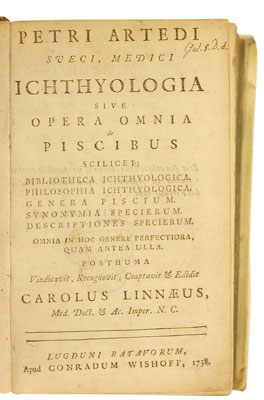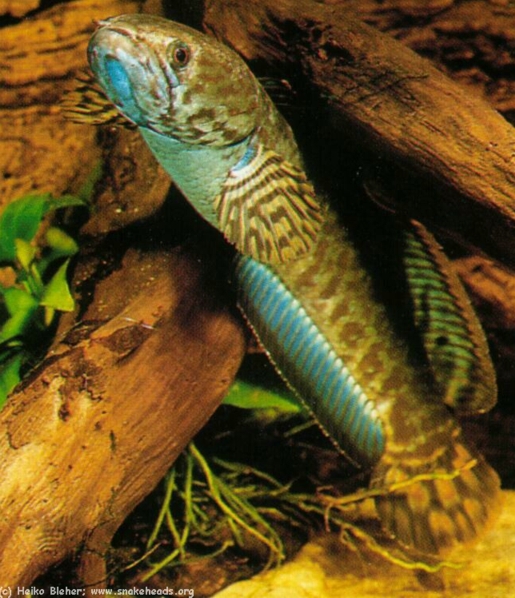
When in 1777, Giovanni Antonio Scopoli published a book which, inter alia erected 3 three new fish genera including Channa (family Channidae), he had no idea that these snakeheads , as they are commonly known, whose distribution extends from Afghanistan to New Guinea to the south and Japan to the east, had an accessory respiratory organ which functions rather like our lungs, allowing them to breathe atmospheric air. He also had no idea of their true appearance, as he had seen only dead specimens. It is not only the anatomy of Channa that is interesting, the genus has a fascinating and chequered taxonomic history as well, as you will see from this special feature on the snakeheads.
The naturalist Giovanni Antonio Scopoli (1733-1799), also known as Johann Anton Scopoli, was, like Vivaldi, Arcimsole, and a number of others, of dual nationality (Italian and Czech), or rather, regarded himself as a citizen of the country where he was living at any particular time. This was not uncommon in the 18th century. In 1777 Scopoli, published, in Prague, a treatise on all the living creatures, plants, and minerals known at that time; this work, written in Latin, was titled introductio ad historiam naturalem, sistens genera lapidum, plantarum, et animalium hactenus detecta, caracteribus essentialiltus donata in tribus divisa, subinde ad leges naturae and in it Scopoli erected 3 new genera of fishes. Otherwise, however, the treatise consisted almost entirely of Linnaeus' work of 24 years previously and material published by Gronovius.
Linnaeus, himself a botanist, had in turn based the fishes section of the 1759 edition of his Systema Naturae on the work of Artedi, the father of ichthyology .
Linnaeus was, however, responsible for formalising the binomial system of nomenclature, and giving all the animals and plants known at that time a two-part name (= binomen) consisting of one name for the genus and one for the species. In consequence 1758 is, to naturalists, what the birth of Christ is to much of the rest of the world: the Oate from which all else is reckoned. Only names published after 1758 are regarded as valid by modern scientists, although there are, of course, other criteria for validity.
Interestingly Artedi (who sadly drowned in an Amsterdam canal at the age of only 31) and his pioneering work on fishes, Genera piscium , are "pre-Linnaean" and nowadays generally disregarded even though he deserves some of the credit given to Linnaeus.
 | The title page of Artedi's Genera piscium |
Likewise, although Gronovius (the Latinised form of Gronow, just as Linnaeus is the Latin for Linné - it was the fashion for early scientists to Latinise their names for professional purposes, and, indeed, to write in Latin) published his Zoophylaceum in 1763 and was thus nominally "postLinnaean", his work is not accepted as it does not use the binomial system. Nevertheless, his work, like that of Arteiii, is of tremendous scientific value. It was in fact he that first originated the name Channa , describing this as well as other wellknown genera such as Erythrinus, Anostomus, Charax (all characins), and Mastacembelus, to mention but a few. Gronovius' work was in fact accepted for a long time, and genera such as Charax Gronovius, 1763 remained valid until thrown out by the International Commission on Zoological Nomenclature (ICZN) (Opinion 261). The Zoophylaceum (and other works by Gronovius) do not conform to the rules of Linnaeus' binomial system. Happily, however, many of his names do survive, thanks to Giovanni Antonio Scopoli (which goes to show that plagiarism has its uses!). Opinion 329 of the ICZN (1955) declares that Scopoli published Gronovius' names in binomial form in 1777 , and they are thus valid. The word of the ICZN is law in such matters.
We have yet to mention Mark Eliezer Bloch, a doctor 1 born at Ansbach near Frankfurt, who described 1519 species of fish, with text and drawings, in his two mammoth works: Ökonomische Naturgeschichte der Fische Deutschlands (written between 1782-1784) and Naturgeschichte der Ausländischen Fische (1785-1795). (Sadly Bloch did not live to see the revised version of his work published this was done by his friend Schneider, under their joint names, in 1 Ill). They were quite unique and remain highly regarded to the present slay; the splendid illustrations command the highest prices worldwide, and first edition cost hundreds of thousands of dollars, assuming they are available at all.
Bloch gave the snakeheads a different name, Ophicephalus ( the British naturalist, Hamilton (1822) changed the name erroneously to Ophiocephalus and the mistake was followed by subsequent authors, not until 1986 when the Belgian ichthyologist Dr Teugels, synonymise Ophiocephalus with Channa), but only in 1793, so it is considered a junior synonym of Channa, although there are still authors who use the later, invalid name. Bloch's life was an interesting one - but more of that in a future issue, as it is now time to return to the living fishes, the snakeheads.
One of the first descriptions of specimens imported alive appeared in Aquarien- und Terrarienkunde in 1914, and goes as follows: "Ophiocephalus (marulius ?) 2 is, like all ophicephalids, a true freshwater fish. The specimen shown here is drawn from nature, and comes from the Niger. The natural habitat of snakeheads today's valid genera Channa and Parachanna) lies in Africa and Asia. They inhabit shallow water, both still and flowing, preferring the shallow bank zone where they prey on toothcarps. Small specimens have Iseen imported for the aquarium hobby, but they are unsuitable for the home aquarium apart from the largest of communities. On the other hand their attractive colours and markings render them pleasing to the eye..." The account goes on to say that the first specimen to be imported "alive" from Africa was transported in a can with some Pelmatechromis (now Pelvicachromis) pulcher. During the long voyage the 20 cm long snakehead choked on one of these small cichlids and died. The article also mentions that snakeheads possess a labyrinth organ (see below) and are thus capable of breathing atmospheric air.
The labyrinth is a special accessory respiratory organ, found in fishes which generally inhabit oxygen-depleted waters. Snakeheads have a labyrinthlike organ, consisting of two chambers, one on each side of the head above the gills, containing bony plates covered in a membrane rich in capillary veins, which absorb atmospheric oxygen into the circulatory system. They have two narrow tubes (see diagram) connecting the swim bladder with the two labyrinth chambers.
The French naturalist and zoologist Cuvier, who died in 1832, was apparently the first author to remark the presence of a labyrinth in snakeheads, but he remained unaware of its true function, believing it to be a water storage chamber, intended to enable the fish to keep its gills moist during times of drought when there was insufficient water to cover them. 3 Only later was it discovered that the labyrinth actually enables the fish to breathe atmospheric air. In scientific circles it is known as the suprabranchial organ, and is similar to, but not homologous with, that of the labyrinth fishes (Anabantoidei).
Accessory respiratory organs are but one example of the immense adaptability of freshwater fishes, some of which are survival specialists par excellence. Many of them have to contend with huge variations in their environment - dry and rainy seasons, years of drought followed by sudden flood, huge variations in water chemistry, oxygen depletion, temperature fluctuations - I myself have measured temperatures of 40-46°C in a small pool containing millions of fish in the Mato Grosso. There is hardly anything comparable elsewhere in the animal kingdom.
Almost innumerable myths about snakeheads have sprung up in Asia over the millennia. There is room to mention just one here, that of the Karens of Myanmar, who believe that these fishes were once men, who were transformed into fish as the penalty for their sins. And eating snakeheads is said to turn the eater into a lion (the symbol of power among many peoples). Let us hope that this latter belief doesn't become too widespread, else the outlook for the seafish" (see box) will be gloomy, and Gronovius will probably turn in his grave. Snakeheads are wonderful creatures, which have to be kept in order to appreciate them fully. Their survival skills are almost unsurpassed. The colours of some species are a match for those of any coralfish and they are much easier to keep than the majority of domestic pets. But do keep a tight cover on the tank, or else you may find your snakehead curled up with the dog or cat!
Some of the data included herein were researched with the aid of Jacques Géry, the world famous French ichthyologist, whose recent 80th birthday was celebrated, with a curriculum vitae, in aqua, Journal of lchthyology and Aquatic Biology, Vol.2 (4), Decemeber 1997, and Dr Keith Banister from England.
The above given statements about the snakeheads, their biology and behaviour, are facts discovered by the author during many years of research in nature and in aquaria.
The genus Channa belongs to the family Channiciae, which contains a second genus, Parachanna, found exclusively in Africa. The family Channidae is currently regarded as belonging to the order Channiformes, although science is by no means unanimous on this point. Because of their labyrinthlike organ, it has been suggested that these fishes should he classified along with the socalled labyrinth fishes (Order Perciformes, sub-order Anabantoidei) of the families Anabanticiae, Belontidae, Helostematidae, and Osphronemiodae, which all evolved at a much later elate. That viewpoint is nowadays regarded as incorrect however, and it seems rather more likely that the Channitermes are more closely related to the Synbranchiformes and Mastacembeliformes than to the perciforms, whatever some authors may say.
The African genus, Parachanna , with 3 species described to date is distributed across almost all of the black continent, including Madagascar, though it is thought that the single species found there is introduced.
In English-speaking countries both genera are known as snakeheads. The Greek word channe means "seafish" and in turn derives from the Greek word meaning to yawn; the term was applied particularly to serranids by the ancients, because they always died with their mouths open. Ophicephalus means, quite simply, "snakehead".
Snakeheads are elongate fishes with large mouths. All have a long dorsal and anal fin, but not all have pectorals in some species the latter are very small, virtually atrophied, while in others they are completely absent. There are species that grow to more than a metre in length, while others remain very small, eg Channa bleheri .
 | Bleher's first import of Channa bleheri |
This species, discovered by Reepak Nopany and myself, attains only about 20 cm.
All exhibit parental care: some are mouthbrooders , others lay their eggs , sometimes numbering more than 5.000, in nests.
In nature snakeheads feed mainly on other fishes (they sometimes eat each other!), insects, and crustaceans. In captivity they are easy to maintain on frozen, tablet, and pelleted fish foods, together with pieces of raw fish, and shrimps, prawns, especially in the case of larger specimens.
In Asia snakeheads are an important source of protein in some countries, especially in areas where river fish are, of necessity, the main source of food. Almost every market, whether it be in Pakistan, India, Bangladesh, Myanmar, Thailand, Laos, Vietnam, China, Malaysia, or elsewhere, has Channa on display.
 | The larger species of Channa are loved by Asians for dinner. In Chinese kitchen it is even health food. Even in Chinese medicine Channa can be found. If you want try yourself, you can find it frozen or fresh in Asia shops. Recipes can be found on this site here. |
This article was originally publish as: Bleher, Heiko: Channidae in Aqua geographia, Vol 16. 1998 pp. 84-88. The permission for republishing is given by Heiko Bleher. So for the pics. Thank you very much for it. We want to encourage to buy Aqua Geographia with ISSN 1126-8956 directly in Heiko Bleher's company
1 Many famous ichthyologists were (or are) medical doctors, e.g. Bloch, Agassiz, Gunther, Pellegrin, Gery, etc. Back
2 At that time the only described species was Channa marulius from Asia, and the same name was incorrectly applied to the similar-looking exotic imports from Africa, which were probably Parachanna obscura from Nigeria. Back
3 Cuvier's assumption was indeed correct, as the atmospheric oxygen has to dissolve in water before it can lee absorbed likewise the discharge of CO2, so the organ is a water storage system too. The organ cannot absorb oxygen unless the chamber is kept moist, and it is easier to retain water in the chamber and keep it moist than to keep the gill lamellae moist. Back
| © 2001 - 2004 snakeheads.org | HOME of this page |